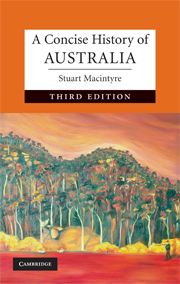Book contents
- Frontmatter
- Contents
- List of illustrations
- Acknowledgements
- Map 1.1 Australia: the main rivers, cities and towns
- 1 Beginnings
- 2 Newcomers, c. 1600–1792
- 3 Coercion, 1793–1821
- 4 Emancipation, 1822–1850
- 5 In thrall to progress, 1851–1888
- 6 National reconstruction, 1889–1913
- 7 Sacrifice, 1914–1945
- 8 Golden age, 1946–1974
- 9 Reinventing Australia, 1975–2008
- 10 What next?
- Sources of quotations
- Guide to further reading
- Index
6 - National reconstruction, 1889–1913
- Frontmatter
- Contents
- List of illustrations
- Acknowledgements
- Map 1.1 Australia: the main rivers, cities and towns
- 1 Beginnings
- 2 Newcomers, c. 1600–1792
- 3 Coercion, 1793–1821
- 4 Emancipation, 1822–1850
- 5 In thrall to progress, 1851–1888
- 6 National reconstruction, 1889–1913
- 7 Sacrifice, 1914–1945
- 8 Golden age, 1946–1974
- 9 Reinventing Australia, 1975–2008
- 10 What next?
- Sources of quotations
- Guide to further reading
- Index
Summary
The Jondaryan station occupied 60,000 hectares of grazing country in the Darling Downs district of south Queensland in the 1880s, and employed seventy hands. Twice a year, in late spring and early autumn, some fifty contract workers would assemble there and cut away the fleece of more than 100,000 sheep. They lived in primitive quarters close to the shearing-shed, where six days a week from sun-up to sun-down they bent down over the ewes and plied their shears. Charges for rations and fines for improperly shorn sheep or other infractions were deducted from their earnings. In the late 1880s the Queensland shearers formed a union to secure better pay and conditions, and by December 1889 it had enrolled 3000 members. The union demanded that pastoralists employ union members only; the Darling Downs employers refused.
The shearers gathered at Jondaryan in September 1889 and set up camp till the manager acceded to their demands. The manager sought non-union labour to break the strike: as one shearer put it, the station ‘got a lot of riffraff from Brisbane who “tommy-hawked” the wool off somehow’. But when the wool bales were railed to Brisbane for shipment to England, the waterside workers refused to handle them and declared the wool would ‘stay there till the day of judgement and a day or two after’ if the owners of Jondaryan did not concede the union conditions.
- Type
- Chapter
- Information
- A Concise History of Australia , pp. 122 - 155Publisher: Cambridge University PressPrint publication year: 2009



